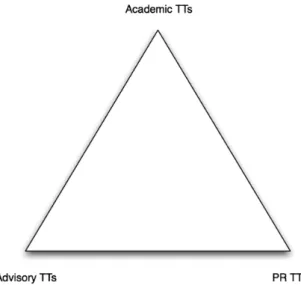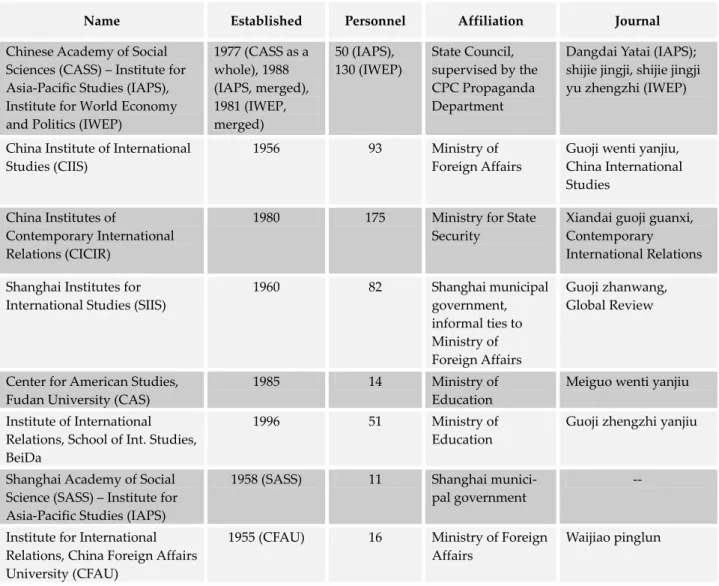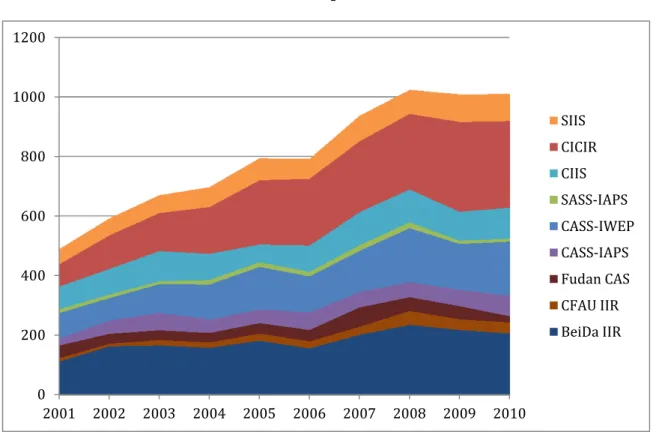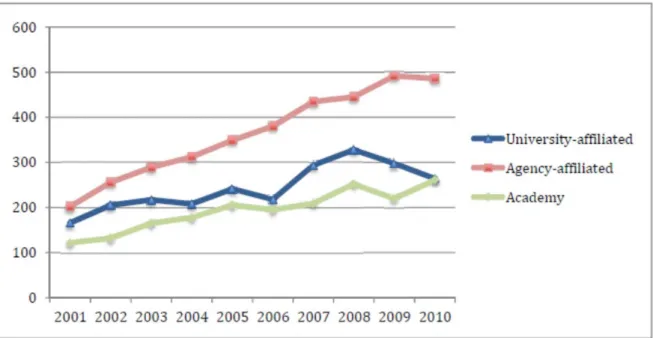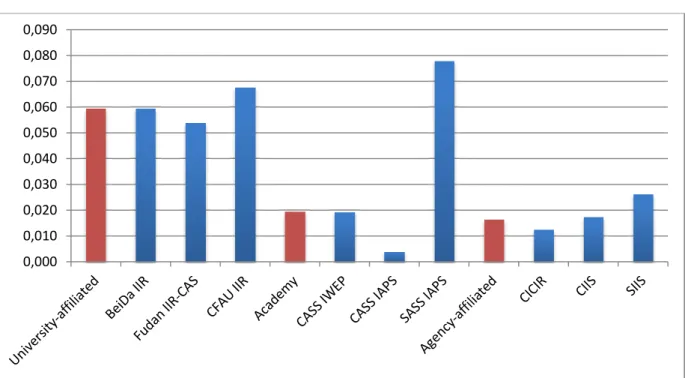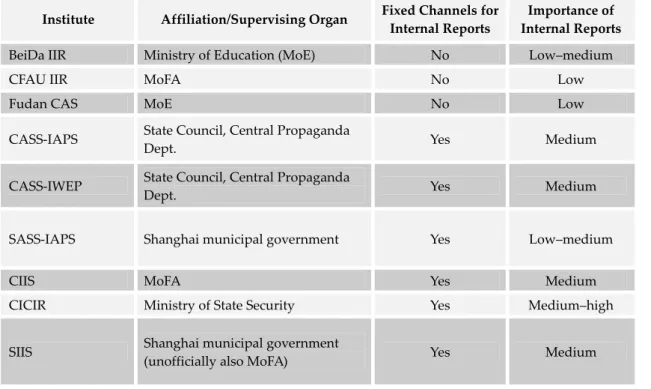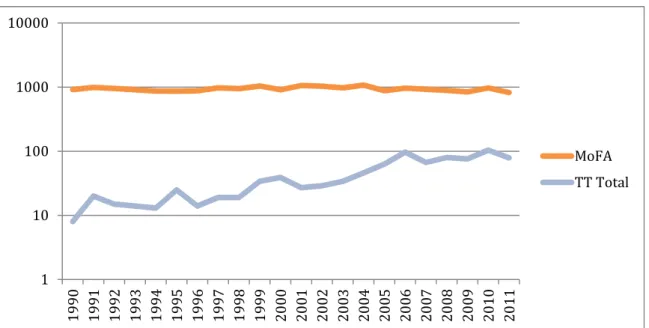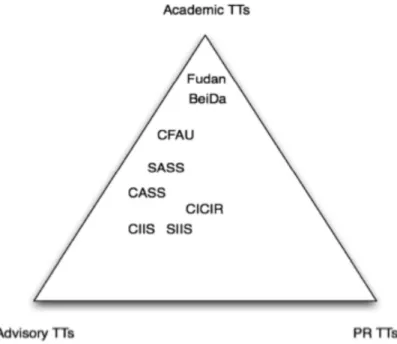eas and academic debate. orking Papers series does not constitute publication and should not limit publication in any other venue. Copyright remains with the authors.
GIGA Research Unit:
Institute of Asian Studies
___________________________
China’s Foreign Policy Think Tanks:
Changing Roles and Structural Conditions Pascal Abb
No 213 January 2013
Edited by the
GIGA German Institute of Global and Area Studies Leibniz‐Institut für Globale und Regionale Studien
The GIGA Working Papers series serves to disseminate the research results of work in progress prior to publication in order to encourage the exchange of ideas and academic debate. An objective of the series is to get the findings out quickly, even if the presenta‐
tions are less than fully polished. Inclusion of a paper in the GIGA Working Papers series does not constitute publication and should not limit publication in any other venue. Copy‐
right remains with the authors. When working papers are eventually accepted by or pub‐
lished in a journal or book, the correct citation reference and, if possible, the corresponding link will then be included on the GIGA Working Papers website at
<www.giga‐hamburg.de/workingpapers>.
GIGA research unit responsible for this issue:
Institute of Asian Studies
Copyright for this issue: © Pascal Abb
WP Coordination and English‐language Copy Editing: Melissa Nelson Editorial Assistance and Production: Silvia Bücke
All GIGA Working Papers are available online and free of charge on the website
<www.giga‐hamburg.de/workingpapers>.
For any requests please contact:
E‐mail: <workingpapers@giga‐hamburg.de>
The GIGA German Institute of Global and Area Studies cannot be held responsible for errors or any consequences arising from the use of information contained in this Working Paper; the views and opinions expressed are solely those of the author or authors and do not necessarily reflect those of the Institute.
GIGA German Institute of Global and Area Studies Leibniz‐Institut für Globale und Regionale Studien Neuer Jungfernstieg 21
20354 Hamburg Germany
E‐mail: <info@giga‐hamburg.de>
Website: <www.giga‐hamburg.de>
Changing Roles and Structural Conditions
Abstract
This paper provides an overview of the landscape of Chinese foreign policy think tanks, classifies them according to the activities they pursue, and offers some explanations as to how they have developed their particular characteristics – both at the level of individual in‐
stitutes as well as in the broader national context. To this end, the paper introduces a new typology for the classification of think tanks and takes an in‐depth look at their current ac‐
tivities.
Keywords: think tanks, China, Chinese foreign policy, institutions, policymaking, intellectuals
Pascal Abb, M.A.
is a doctoral student at the GIGA German Institute of Global and Area Studies/University of Hamburg and a member of GIGA’s Research Programme 4: Power, Norms and Gov‐
ernance in International Relations.
Contact: <pascal.abb@giga‐hamburg.de>
Website: <http://staff.en.giga‐hamburg.de/abb>
Pascal Abb
Article Outline 1 Introduction 2 Typology
3 Case Selection and Description
4 The Historical Development of China’s Think‐Tank Sector, 1949–Present 5 Current Activities and Roles
6 Conclusion Bibliography
1 Introduction
As a result of its fast‐paced development, China has increasingly gained recognition as a cru‐
cial international actor whose decisions will play no small part in shaping the twenty‐first century.1 This is due to both the impressive expansion of its economic and military capabili‐
ties, which are usually understood as key elements of state power, and the country’s key role
1 This paper is an excerpt from an ongoing dissertation project on the development of Chinese foreign policy think tanks. I am particularly grateful for the comments that Nele Noesselt and Patrick Köllner offered on sev‐
eral versions in the lead‐up to its publication. All remaining errors are my own.
in several high‐profile international relations (IR) issues. Given China’s activities in foreign policy and strategy in general, it is unsurprising that the country’s political decision‐making processes have also attracted considerable interest in recent years. Although the nontrans‐
parent nature of China’s political system makes it very difficult to actually trace these pro‐
cesses and to uncover the structures that shape them, there has been no shortage of publica‐
tions on this topic.2 In particular, a number of Western scholars who focus on the country’s foreign policy have identified Chinese think tanks (TTs) as a key component in this decision making.3 The recent attention to these institutes has been due not only to practical considera‐
tions (academics are usually much more accessible to foreign scholars than officials), but also to the recognition of their increasing domestic and international profile. Several Chinese scholars (e.g. Chen 2009, 2010; Sun 2004; Zhao 2011) have explored this issue as well, con‐
tributing to the growing body of research on the question of policy influence.
As the Chinese government has had to confront a host of new issues and problems at the international level, these institutes and their scholars have thrived on supplying advice to offi‐
cials. At the same time – and as a result of the overall maturation of China’s research system – they have been enhancing their academic clout and participating in more abstract, theory‐
oriented debates about IR topics. Finally, China’s think tanks have also increased their public visibility and have emerged as a key supplier of expert analysis in the media, thereby reach‐
ing a broader audience and perhaps paving the way for their role as policy advocates. Not unlike their counterparts in other countries, Chinese think tanks now strive to fulfill a multi‐
tude of roles simultaneously: as advisers, academics and advocates, they are engaged in all the major spheres of policy debates. The totality of these three roles is something that has so far received little attention in existing studies, most of which have focused either on devel‐
opments in one specific field of activity, have gauged the extent of think tanks’ influence over policy, or have provided extensive descriptive studies of individual institutes.4 Accord‐
ingly, this paper aims to provide an account of how the landscape of China’s foreign policy
2 For general information on the making of foreign policy in China, see, for example, Heilmann (2004), Lai (2010), Lampton (2001), Lu (1997), Robinson and Shambaugh (1994).
3 In particular, China Quarterly dedicated a whole issue to this topic in 2002: Gill and Mulvenon (2002) discuss military‐related research organizations; Glaser and Saunders (2002) focus on foreign policy think tanks; Sham‐
baugh (2002) tackles the closely related field of research institutes in the field of IR. In addition to these contribu‐
tions, Shai and Stone (2004) discuss the influence of Chinese history and culture on the development of China’s system of foreign policy think tanks. Glaser and Medeiros (2007) provide a case study of how China’s “peaceful rise” doctrine originated in (and was subsequently challenged by) circles of academics and advisors. Bondiguel and Kellner (2010) provide an overview of the most important institutes and their most recent activities.
4 For example, Johnston (2003) and Shambaugh (2011) focus on academia; Glaser and Medeiros (2007), Halpern (1988) and Liao (2006) on advisory functions and influence on policymaking. While there do not seem to be any studies that focus specifically on media activity, Glaser and Saunders (2002) and Zhu (2009) treat this as one aspect of influence in general. Shambaugh (2002) and Shai and Stone (in Stone and Denham (eds), 2004) provide comparative accounts of several institutes but focus mostly on factors such as size, prestige and ad‐
ministrative linkages.
think tanks has developed over the past decade. In particular, I try to show how these insti‐
tutes put different emphasis on the three essential roles outlined above, as well as to offer some explanations for how they have obtained their particular characteristics. I argue that several distinct groups, or clusters, of institutes can be identified according to their activities and administrative affiliations.
While the scope of this study is limited to the case of China, I also seek to introduce a novel typology for classifying think tanks that could prove useful in comparing these insti‐
tutes across national boundaries and, most importantly, different political systems. This framework is introduced in Section 2, since it informs the subsequent empirical observations.
Section 3 briefly describes the cases selected for this study, while Section 4 provides an over‐
view of their general development from their inception up to the most recent initiatives un‐
dertaken by the Hu administration. Section 5 proceeds to map out the characteristics of each institute according to the three dimensions outlined above and identifies their general devel‐
opment patterns. Section 6 concludes by summarizing these trends, offering explanations of how the current system acquired its characteristics, and discussing their relevance.
2 Typology
The most well‐known typology for classifying think tanks is probably the one introduced by Weaver (1989) in order to analyze the landscape of US policy research institutes, which were booming at the time. This classification divided them into “universities without students,”
“contract researchers” and “advocacy tanks,” a division which captured their essential activi‐
ties very well and is therefore still widely used for analyzing American and Western think‐
tank systems. A subsequent reformulation by McGann and Weaver (2000) expanded this model to include “party tanks,” which are somewhat similar to advocacy organizations but have permanent affiliations with political parties instead of exhibiting the independence and issue focus that is characteristic of the former. However, this approach rests on a foundation that tends to locate think tanks in the realm of civil society rather than the government or its various bureaucracies. This is understandable when the American pedigree of most initial studies in this field is taken into account, but it poses significant problems when one at‐
tempts to take stock of research institutes in state‐dominated societies such as China and many other developing nations.
To be sure, there is now a substantial body of Chinese literature that tackles this problem and maps the specific features of the country’s think‐tank landscape in great detail. Zhu (2009b) divides institutes by organizational status: “semi‐official” (meaning that while they are not directly part of a government agency, they are still subordinate to one); private for‐
profit companies; private nonprofit organizations; and university‐affiliated TTs. Regarding the more narrow subset of foreign policy research institutes, Chen (2009) devises categories based on organizational features. Four of these categories are based on institutional affilia‐
tion (with the Ministry of Foreign Affairs (MoFA), the Academy of Social Sciences (CASS), universities or the military), while the others are distinguished as “public diplomacy” TTs, academic societies, and nongovernmental institutes.
These classifications underscore the dominant role of the state in China’s knowledge economy, and they capture valuable details about the full range of state organs that maintain policy research capabilities. However, a completely country‐specific model would entail abandoning substantial opportunities for making the findings applicable to cross‐national comparisons, as well as the additional risk of a priori essentializing certain types of institutes regardless of the empirical realities and ongoing shifts in the roles of such institutes. Hence, this section outlines a novel approach to think‐tank classification that rests on two premises:
First, all policy research institutes perform activities that can be subsumed under three gen‐
eral roles – academic, advisory, and public relations/advocacy. Second, most if not all such institutes do not focus on any of these areas exclusively, but rather perform all of these roles simultaneously, while prioritizing certain activities. Accordingly, it would be unwarranted to classify them as ideal types, and it is much more promising to locate them on a spectrum be‐
tween these extremes.
Since this approach assumes a split between three main roles, it is appropriate to visual‐
ize this spectrum or continuum as a triangle, with each corner corresponding to one of these roles (Figure 1). It is possible to map any observed case within this spectrum while describ‐
ing the degree to which it prioritizes each of the roles and the associated activities. Since any organization has to make basic strategic decisions about how to allocate its limited resources between different areas of activity, this simple model makes it easy to visualize an essential feature of role prioritization: the closer a case is located to one of the extreme points, the fur‐
ther it is away from the two others. An institute that does not have any kind of priorities would be located at the exact geometric center of the triangular spectrum, while one that fo‐
cuses exclusively on one of them would be located at the corresponding corner.
Figure 1: Triangular Continuum of Think‐Tank Roles
The advantage of this typology is that it allows for both a great deal of precision in locating each case relative to the others and offers maximum flexibility in assigning cases to groups of subtypes, should this be desired. The latter point is of special importance, as it avoids the problem of essentialization and allows for the creation of subtypes that are contingent upon the actual observation instead of constraining to it. Hence, this approach is not only useful for the immediate needs of this particular article, but would also make it possible to compare the results with other country‐specific studies or to make them available for further work in this field. It would, for example, be possible to see if other nations feature similar “clusters”
of institutes (that exhibit a comparable degree of focus on each of the three roles), and then to perform a comparative causal analysis by identifying similar systemic features between both nations that may explain such resemblances.
3 Case Selection and Description
The notion of what exactly constitutes a “think tank” – the essential definition for this study’s core concept – has been very much in flux over the past few decades, not least be‐
cause of the substantial increase in the diversity of policy research organizations and the spread of such institutes across the world. This understanding was initially shaped mostly by a small group of prominent American institutes that dated back either to the progressive era (for example, Brookings) or World War II (RAND). Researchers subsequently expanded this narrow focus on technocrats and academics in order to accommodate the expanding role of think tanks in political struggles, either through their direct attachment to political actors (for example, the German party foundations) or their identification with an ideological movement (most notably, the “new partisans” associated with American conservatism).
Taking these developments into account, this study aims to cast the net as widely as pos‐
sible and defines a think thank simply as a public policy research organization – in other words, an organization whose research is intended to influence policies through the variety of means described above. This is mostly in keeping with the most recent publications on this topic (McGann and Sabatini 2011), except that it drops the notion of independence from government structures. It also allows for the inclusion of institutes affiliated with universi‐
ties, which – while usually considered an altogether distinct form of organization – have come to play the same roles in China.5 Accordingly, it identifies a number of prominent re‐
search institutes specializing in foreign policy research, IR and area studies, the full list of which is provided in Table 1. The final selection has been informed by the following criteria:
5 Universities and other “higher education institutes” (HEIs) have been explicitly instructed to perform the function of think tanks for state and party; see section XIII, article 49 of the Action Scheme for Invigorating Education Towards the 21st Century (Ministry of Education 1999).
— Prominence and influence. Cases were chosen from recent rankings and descriptions of influential Chinese foreign policy think tanks, both Western and local.6 This resulted in the inclusion of a number of rather large organizations with a long and distinguished record in the field (for example, CASS and CIIS), as well as smaller, specialized research centers that are part of larger organizations but enjoy special prestige or prominence (for example, Fudan University’s Center for American Studies). Notably, almost all of the in‐
stitutes on this list publish top‐ranked “core” journals, something that attests to their in‐
fluence in scholarly policy analysis.7
— Accessibility. Due to the close relationship between the institutes and the state (and party) in China, as well as the sometimes sensitive nature of foreign policy, pragmatic concerns also had an impact on the final case selection. Some institutions that are undoubtedly in‐
fluential, such as the National Defense University’s Institute for Strategic Studies and the policy research arm of the Central Party School, had to be dropped because of their inac‐
cessibility to foreign scholars and the general unavailability of information about them.
All but one of the institutes in the final sample could be visited in person, the one excep‐
tion being the China Institutes of Contemporary International Relations (CICIR). However, this institute now has a substantial footprint of publicly available information).
— Diversity. As mentioned above, think tanks now come in many different forms. China is no exception in this regard, despite the lack of nonstate agency in setting up research in‐
stitutes. Accordingly, the final selection includes several distinct organizational forms:
university‐affiliated research centers, large comprehensive “academies,” and specialized institutes affiliated with elements of the bureaucracy such as the foreign ministry. While it would have been very interesting to include nongovernmental institutions as well, no such case could be identified. This may well be due to the lack of public contestation of foreign policy in China.8
6 See, for example, Shai and Stone (2002), Shambaugh (2002), Bondiguel and Kellner (2010), Chen (2009) and Zhao (2011) for systematic overviews. For explicit rankings, see McGann (2011) as well as Li (2006).
7 The index of core journals (hexin qikan) is maintained by Beijing University and updated every four years, with the most recent one compiled in 2008. For details, see the Beijing University catalogue of Chinese‐
language core journals, 2008 edition (beijing daxue hexin qikan mulu 2008 nian ban).
8 In notable contrast, the field of economic policy, and especially the issue of market reform and liberalization, has already seen the establishment of prominent independent players such as the Unirule (Tianze) Institute and the Boyuan Foundation.
Table 1: Key Characteristics of Selected Think Tanks
Name Established Personnel Affiliation Journal
Chinese Academy of Social Sciences (CASS) ‒ Institute for Asia‐Pacific Studies (IAPS), Institute for World Economy and Politics (IWEP)
1977 (CASS as a whole), 1988 (IAPS, merged), 1981 (IWEP, merged)
50 (IAPS), 130 (IWEP)
State Council, supervised by the CPC Propaganda Department
Dangdai Yatai (IAPS);
shijie jingji, shijie jingji yu zhengzhi (IWEP)
China Institute of International Studies (CIIS)
1956 93 Ministry of
Foreign Affairs
Guoji wenti yanjiu, China International Studies
China Institutes of
Contemporary International Relations (CICIR)
1980 175 Ministry for State Security
Xiandai guoji guanxi, Contemporary International Relations
Shanghai Institutes for International Studies (SIIS)
1960 82 Shanghai municipal
government, informal ties to Ministry of Foreign Affairs
Guoji zhanwang, Global Review
Center for American Studies, Fudan University (CAS)
1985 14 Ministry of
Education
Meiguo wenti yanjiu
Institute of International Relations, School of Int. Studies, BeiDa
1996 51 Ministry of
Education
Guoji zhengzhi yanjiu
Shanghai Academy of Social Science (SASS) – Institute for Asia‐Pacific Studies (IAPS)
1958 (SASS) 11 Shanghai munici‐
pal government
‐‐
Institute for International Relations, China Foreign Affairs University (CFAU)
1955 (CFAU) 16 Ministry of Foreign Affairs
Waijiao pinglun
Source: Author’s compilation based on information obtained from institute websites.
4 The Historical Development of China’s Think‐Tank Sector, 1949–Present
This section summarizes the historical development of China’s think tanks up to the present day. In doing so, it focuses particularly on how they have reacted to political shifts within the country’s ruling elite, and the resulting changes in the kinds of services that have been de‐
manded from them. Since Chinese research institutes are overwhelmingly dependent on the state and the party for their survival,9 it can be assumed that this close relationship results in a high degree of responsiveness on the part of the institutes: experts and policy researchers have to react to these shifts and the different visions of how they should contribute to the cause of regime preservation. How have the strategic shifts undertaken by decision makers
9 According to budget reports released by individual institutes, the share of direct appropriations in their total in‐
come ranges from slightly below 50 to over 80 percent. The role of government funding is the lowest at universi‐
ties like BeiDa and Fudan, because they can secure significant revenue from student fees and business income.
affected the setup and subsequent fates of policy research institutes in China? This question is best addressed by considering several different periods in the history of the People’s Republic of China (PRC) that can be clearly distinguished on the basis of changing elite objectives and actions. The time span between 1949 and 2002 is discussed here only briefly, as there has al‐
ready been substantial research on these events and how they influenced the China’s think tanks. Greater attention is given to recent developments under the Hu administration.10
The initial period between the establishment of the PRC and the start of the Cultural Revolution (1949–1966) was marked by very intensive institution building. This was the re‐
sult of the dual necessities of, first, rebuilding a country devastated by two decades of civil war and foreign invasion and, second, establishing the administrative structures necessary to carry out the Communists’ far‐reaching plans for social transformation.11 Institutes estab‐
lished during this time usually reflected the Soviet model of separation between education (centered around universities) and research (academies and specialized institutes).12 The So‐
viet practice of ensuring entanglement between party and state administrations was also adopted – that is, the “dual rule” according to which an institute’s leadership was responsi‐
ble to its superordinate state agency and controlled by the organization’s local party group (Zheng 1997: 79–83).
However, the overall capabilities of these newly established institutes and centers were rather limited, for a number of reasons: China had been a severely underdeveloped country to begin with; its education system had been disrupted by revolutionary struggles and wars;
and the expertise of scholars from the prerevolutionary generation was often rejected due to ideological differences (DeGlopper 1987). It is not surprising that the lack of resources and the regime’s focus on ideology‐driven transformation brought about a state of affairs in which Marxism was the only acceptable theoretical lens that could be applied to the study of international relations, and in which the role of scholars was mostly reduced to interpreting and backing standing government policy, as well as to denouncing the actions of designated enemies such as the United States. The concentration of foreign policy decision‐making in the hands of a small, relatively isolated circle of top leaders also limited the institutes’ oppor‐
tunities to offer consultation, thus further inhibiting the development of China’s policy re‐
search capabilities.
As inauspicious as this start was, things took yet another dramatic turn for the worse during the decade from 1966 to 1976, as the Cultural Revolution swept through the country.
10 In addition to several aforementioned authors, see Bondiguel and Kellner (2010), Glaser and Saunders (2002), Lampton (2001), Li (2006), Tanner (2002).
11 See Zheng (1997) for a very detailed description of this period and state–party interactions in early postrevolu‐
tionary China.
12 See Graham (1993) on the features of the Soviet research system. In general, this field was marked by the same approach to governance as the USSR’s economic system: centralized planning, strict vertical hierarchies, con‐
trol for political conformity, and administration by party officials.
While universities had been their ground zero, the frenzied revolutionary campaigns soon engulfed most of the research system as well: institutes had to shut down, and publication ceased. Several campaigns that directly targeted scholars and scientists led to ideological purges and the sending of millions of students and researchers to the countryside, severely interrupting the education of yet another generation of Chinese. The effects of the Cultural Revolution were of course not limited to intellectuals, with large‐scale social turmoil disrupt‐
ing the country in 1968. These excesses ultimately led to the downfall of the Chinese Com‐
munist Party’s (CCP) radical revolutionary faction and a resurgence of the bureaucratic‐
administrative establishment. This allowed for a comprehensive reorientation of the state towards more tangible developmental goals.
Since China’s backwardness in science and technology had been identified as one of the main reasons for the country’s stalled development, this sector became a key target of re‐
forms in the new period.13 Within the social sciences, research on economics and foreign studies was designated as crucial to the reform project, leading to the systematic rebuilding and expansion of existing capacities. Most notably, the Chinese Academy of Social Sciences (CASS) was established in 1977 from the existing division of philosophy and social sciences of the comprehensive Academy of Sciences (CAS) and put under the direct control of the State Council, which designated it as a ministry‐level unit. Many of the Soviet‐style practices in China’s research system were subsequently abolished in favor of Western‐inspired re‐
forms in the mid‐1980s: science funding was decentralized; individual researchers and insti‐
tutes were given more freedom to launch their own projects and to contract research; and universities were allowed to design their own curricula.14
As linkages with the outside world increased as a result of the economic opening and strategic technology imports, so did the demand for more information about China’s new‐
found partners. Policy analysis and short‐term research on concrete issues soon emerged as the dominant form of international studies. Ultimately, the push to adopt Western frame‐
works also left its mark on this discipline, with the gradual introduction of foreign IR theo‐
retical schools such as realism.15 While the vast majority of publications from the 1980s re‐
mained atheoretical in nature, this exposure had especially important long‐term effects through the introduction of Western theories into student curricula. After the turmoil of the
13 See Goldman (1981: 214–232) for a detailed study of Deng Xiaoping’s personal efforts at and early focus on developing China’s science and technology system.
14 On the reforms of Chinaʹs science and education systems, see Xue (1997) and Tsang (2000), respectively. The key decisions triggering this change in each field were the Central Committee’s “Decision on the Reform of the Science and Technology Management System” (1985) and “Provisional Regulations Concerning the Man‐
agement of Institutions of Higher Learning” (1986).
15 See Shambaugh (2011). The import of foreign frameworks was helped along by the return of foreign‐educated scholars, many of whom had obtained their advanced degrees in the United States. Interestingly, some of the members of this group who established Western‐inspired IR in China (such as Wang Jisi and Qin Yaqing) are now among the most vocal proponents of establishing an “IR theory with Chinese characteristics.”
revolutionary era and especially the Cultural Revolution, this new generation of scholars was the first to enjoy an uninterrupted and skill‐focused professional education. The old guard (composed primarily of generalists and practitioners) was gradually replaced by younger IR specialists. This had a major impact on both the capacity and the outlook of China’s research community.16
Towards the end of the decade, scholars at newly established and reconstituted institutes became increasingly involved in the intraparty debate on economic and political reform.
CASS became a haven for intellectuals aligned with the liberal wing of the party, and the ma‐
jor source of advisors for Zhao Ziyang’s newly created reformist brain trusts. The Tiananmen crackdown of 1989 and the purge of the liberals’ political patrons was followed by a broader conservative backlash against reform advocates in society, and CASS in particular was put under tighter ideological supervision, which would have long‐term adverse consequences for its clout and efficiency (Sleeboom‐Faulkner 2007a; Shambaugh 2011).
While the resumption of economic reform in 1992 and the easing of regime paranoia al‐
lowed for research activity to revert to its previous path, the new international situation after 1989 brought about additional impetus for change. Great power relations were increasingly seen in a global context (particularly the expectation of an emerging multipolar order) in‐
stead of the narrow triangular diplomacy shaped by China’s Cold War experiences. While area studies continued to thrive, interest in the global level increased as well, bringing with it a new demand for bigger‐picture, more abstract and theoretically focused studies (Johnston 2003; Wang 2002). The country’s substantial economic growth allowed for the allocation of more funds to research and education; an expansion of basic research; and concerted drives to boost the overall quality of universities, institutes and publications. These developments continued to improve the availability of two key resources for research institutes: funds and, perhaps even more importantly, trained staff with extensive academic backgrounds and spe‐
cializations.17
The last decade, which was marked by the transition of power to the fourth generation of CCP leadership centered around Hu Jintao and Wen Jiabao, saw a reaffirmation of the role of policy research and advice in China’s long‐term development plan. Uncommonly early into his tenure, Hu published his administration’s own contribution to the CCP’s guiding ideology,
16 Today, the vast majority of researchers at Chinese foreign policy think tanks are holders of advanced post‐
graduate degrees in relevant fields, something which is in stark contrast to the revolutionaries of the 1950s and the former ministry officials of the 1980s. This shift is also observable in the personal backgrounds of suc‐
cessive generations of institute leaders.
17 For example, the volume of China’s National Fund for Social Science (NFSS, the most important vehicle for project‐specific research funding in this field) grew approximately twentyfold between 1991 and 2011 when adjusting for inflation. Institute salary budgets were also increased in order to enable them to compete for highly educated staff (see Sleeboom‐Faulkner 2007b: 263–273 on the example of CASS), and bonus incentive payments were introduced to improve overall output.
under the label of “scientific development” (kexue fazhan).18 Developed primarily as a re‐
sponse to intensifying social inequality and the resulting tensions, the new doctrine was cen‐
tered on the promise of comprehensive socioeconomic management that would distribute China’s newfound wealth among social groups in a more equitable fashion. While it upheld the general reformist‐technocratic trend, it was at odds with the kind of market‐based laissez faire mechanisms or devolution favored by the liberal avant‐garde, and instead stressed the need for statist intervention informed by scientific findings and expert advice. “Think tanks”
(sixiangku or zhiku) in particular were repeatedly singled out as the key providers of this kind of technocratic knowledge.19
In addition to further expansion of funding for basic research, government agencies also increasingly solicited external consultation and invited open bids for contract research, which resulted in further flexibility and open competition between researchers. State‐run re‐
search institutes had previously been integrated into a rigid vertical hierarchy determined by their principal, with little opportunity for interactions with their counterparts in other sys‐
tems or principals outside of their particular chain of command (Glaser and Saunders 2002).
The borders separating academia from the bureaucracy also became more permeable for re‐
searchers themselves, with external consultants being directly embedded in government agencies or retained for the duration of a specific project.20
However, China’s economic growth and the increasing differentiation of its society didn’t just bring about new challenges for domestic socioeconomic management. As a result of the country’s growing economic clout and ever‐increasing connectedness with the global economy, Chinese leaders also had to tackle a host of new issues and responsibilities that had not been on Beijing’s radar before. The spread of global and regional governance schemes that demanded Chinese participation, as well as the emergence of new issues like climate change, global terrorism and nontraditional security challenges, the development of international law or the workings of global finance created a new demand for specialized expert advice. Compared to the small‐scale research teams in government bureaucracies, in‐
stitutes were much better equipped to tackle these issues due to their broader range of knowledge, the higher creativity and education of their staff, and their international net‐
works. While this period did not involve another wave of institute creation, small‐scale or‐
18 The concept was first introduced by Hu at the 17th Party Congress in July 2003. It was adopted into the party constitution and subsequently introduced into the official mission statements of public agencies in China (among them the institutes under study here).
19 The term sixiangku was almost never used in official speeches before 2004, when a session of the Central Committee especially dedicated to the development of China’s social sciences first introduced the idea that these fields must become “think tanks for party and government” (CCD 2004). According to a query of the CCP database, this approach has been echoed extensively ever since.
20 This practice is particularly widespread in institutes that are directly attached to ministries such as MoFA: for example, CFAU researchers regularly serve in Chinese embassies, and CIIS still retains a contingent of retired diplomats among its scholars.
ganizational change was brought about in the form of the creation of many new research centers that focused on these emerging issues within existing institutes.21 Accordingly, the overall organizational structure of existing institutes gradually shifted away from a division into regional departments towards that of issue‐based units.
Finally, two new developments affected the channels institutes and individual researchers could utilize to communicate their findings and recommendations to decision makers and the general public. First, government agencies emerged as primary consumers of research in‐
tended for academic audiences – in addition to the internal reports they already received from state‐run research organizations.22 The collection and compilation of such findings for decision makers was undoubtedly made easier by the still predominant atheoretical style that characterized policy‐relevant publications. Second, and perhaps more importantly, some scholars and experts took advantage of the relaxation of constraints on public debate and en‐
hanced their public profile through media appearances. While embarking on the path of public advocacy is still mostly the result of individual decisions and career choices, several institutes made public relations and advocacy a key part of their organizational missions, suggesting that this would not only be tolerated but was in some cases also explicitly desired by principals.23 Owing to the growing public interest in international affairs, which has proba‐
bly also resulted from the country’s increasing status, opportunities to publish interviews and commentaries on recent events now abound, and such features have become staples of reports on international affairs in the Chinese mass media. These fora are not, however, venues in which standing government policy can be openly criticized, and comments by experts are usually meant to explain events and policies. This role is not without its critics in the expert community, and individuals who are frequently brought in as commentators risk being dis‐
missed as “media scholars” by their peers. Still, this development has opened up yet another viable career path that goes beyond the former choice between a focus on academia or on advisory functions.
21 For example, both BeiDa and CIIS established research divisions for strategic studies in 2007, and SIIS ex‐
panded its existing center to an institute dedicated to the same issue in 2009. This is most likely due to the in‐
creasing prominence the topic has gained since the middle of the first decade of this century, as can be seen from the NFSS research project suggestions. Some institutes have also acquired unique specializations: CICIR established the first Chinese research center on counterterrorism in 2000, and SIIS launched a center for (com‐
parative) women’s studies in 2001.
22 According to interviews with Chinese researchers, this is the primary reason why government officials have also shifted to considering an institute’s academic clout as one of the most important factors in soliciting advice.
23 Part of SIIS’s official mission statement is to “link the people and the elites” and to increase the public’s un‐
derstanding of international affairs, while CIIS has made “public diplomacy” on behalf of MoFA a recent fo‐
cus of its work.
5 Current Activities and Roles
5.1 Academic Activity
The first key role that modern think tanks fulfill, to varying extents, is the production of aca‐
demic research – that is, material that is published in peer‐reviewed journals; is primarily in‐
tended for an audience of other scholars; and is usually marked by a stronger focus on ab‐
straction, theory testing and development, and long‐term research projects. Accordingly, this subsection explores the key quantitative and qualitative features of the research produced by China’s think tanks.
Figure 2 presents the total number of academic publications produced by each of the se‐
lected institutes during the years 2001–2010. The statistics were derived from the China Aca‐
demic Journals (CAJ) database, a repository for academic publications similar to JSTOR.24 This source was chosen in order to be able to cover a broad span of time and to derive statis‐
tics that are comparable across the cases. The numbers published by the institutes themselves would have been an insufficient alternative, because they are often fragmentary or outright unavailable and employ different counting methods (for example, they may include news‐
paper articles or book chapters).
24 A couple of caveats apply to the interpretation of these numbers: First, while CAJ covers all top‐ranked “core”
journals and a vast number of other publications, some less prominent outlets are missing. Matching the numbers derived from CAJ against publication statistics published by the institutes revealed that in a few cases, the respective journals were not part of the database. Second, this method depends on the correct registration of the author’s affiliation, which is not always the case. Institutional affiliation was rarely recorded before 1999 and is still incomplete for several of the subsequent years, which could explain the initial jump in 2001/02.
Work units that are part of a larger organization, like CFAU’s IIR, could be slightly underrepresented com‐
pared to large institutes like the CIIS or CICIR because the author’s exact departmental affiliation was not rec‐
orded in a few cases (for example, the affiliation is only given as CFAU). A third source of discrepancies is that official statistics published by institutes sometimes contain large numbers of items that are not academic pub‐
lications, but rather newspaper commentaries or essays lumped together under the “article” (lunwen) category.
Additionally, official statistics usually feature only publications by full‐time staff, while CAJ also contains those handed in by Ph.D. students. Accordingly, institutes that train larger numbers of young researchers (mostly universities) may be slightly overrepresented in this count. However, the clear advantage of using CAJ is that its numbers are more easily comparable than those gleaned from statistics compiled by individual institutes using different methodologies – and which in some cases (for example, CICIR) could not be ob‐
tained anyway.
Finally, an additional source of error may be the propensity of researchers to repeatedly publish the same findings in several journals under slightly different titles. Unfortunately, the substantial volume of publica‐
tions makes it impossible to check for this by comparing their actual contents. However, while this factor may serve to inflate the overall publication count of institutes in general, this should be less of an issue regarding the comparability across cases and time. If anything, well‐regarded Chinese journals have recently gotten bet‐
ter at preventing this type of cheating.
Figure 2: Number of Journal Articles Published per Institute and Year, 2001–2010
Source: Author’s compilation of CAJ data.
Many of the pronounced differences between the cases can be readily explained by the sub‐
stantial variety in sheer size the institutes exhibit:25 Figure 3 features the number of publica‐
tions for 2010, divided by the number of full‐time research staff as most recently specified by each institute. A couple of general trends are immediately apparent: First, most institutes were able to significantly increase their total number of publications over the last decade. It is important to note that this feat was apparently achieved without significant concurrent in‐
creases in personnel.26 One major reason for this increase may be the special incentive schemes enacted in some form at all these institutes over the last decade. Since the basic salary of researchers in China is still quite low, bonus payments for publications in top journals are a major incentive – on top of the academic prestige resulting from successful submissions.
Second, much of the overall increase can be attributed to relatively few institutes that boosted their output by very high margins. CICIR alone tripled its publication count in ten years, and its per capita output is now almost at the same level as that of most university de‐
partments, despite the fact that its main mission remains intelligence analysis. BeiDa’s Insti‐
tute of International Relations (IIR), China’s most prominent and best‐staffed university‐
affiliated research institute for IR, almost doubled its total in the same time span and has the
25 Please see Table 1 for details.
26 Concrete statistics showing this are only available for CASS (for example, CASSGO (1998) shows that IAPS and IWEP grew only by approximately 10 percent between then and now); otherwise comments by research‐
ers and administrators are used as a basis.
0 200 400 600 800 1000 1200
2001 2002 2003 2004 2005 2006 2007 2008 2009 2010
SIIS CICIR CIIS SASS‐IAPS CASS‐IWEP CASS‐IAPS Fudan CAS CFAU IIR BeiDa IIR
highest per capita publication ratio.27 Robust growth was also achieved by the CASS insti‐
tutes and agency‐affiliated institutes such as CIIS and SIIS. Apart from the sheer quantity, the research output of China’s IR think tanks is also notable for its high quality, something which is attested to by the fact that between one‐half and two‐thirds of all articles published by the observed institutes appear in core journals.
Figure 3: Number of Publications Divided by Number of Full‐Time Research Staff per Institute (2010)
Source: Author’s compilation based on CAJ and institute website data.
A third feature becomes apparent when cases are grouped according to shared organizational characteristics. We can broadly distinguish between university‐affiliated institutes and re‐
search centers (CFAU’s IIR, Fudan’s CAS and BeiDa’s IIR), institutes that are part of compre‐
hensive academies like CASS and SASS, and specialized institutes affiliated with ministries (CIIS and CICIR) or local governments (SIIS). Notably, the institutes that have historically been most strongly involved in policy analysis and the provision of internal advice have now also emerged as key players in academia and boast the greatest increases in publications (Figure 4).
27 Although this is to some extent due to the biweekly magazine Chinese Entrepreneur (zhongguo qiyejia) being counted as an academic journal, which is somewhat dubious; one single researcher at this institute is a very prolific author for this magazine and wrote at least 14 such pieces in 2010. Some of the caveats mentioned above apply here as well.
0,0 0,5 1,0 1,5 2,0 2,5 3,0 3,5 4,0 4,5
Publications per capita (2010)
Figure 4: Number of Publications per Organizational Group (aggregated from institutes), 2001–2010
Source: Author’s compilation based on CAJ data.
On the one hand, the adoption of “scientific development” has apparently led decision mak‐
ers to demand a higher academic standard from policy‐relevant research projects, and insti‐
tutes have responded accordingly as their overall environment has become more competi‐
tive. On the other hand, it is important not to equate “academic” and “theory‐driven” re‐
search. While both the adoption of Western theories as well as efforts to develop an indige‐
nous Chinese IR theory may have left a slight imprint on the relevant publications, descrip‐
tive or atheoretical analytical approaches still dominate. This can be seen as a side effect of the strong representation of nonuniversity institutes. Figure 5 presents the estimated share of theory‐oriented articles among all publications in the observed period (2001–2010), both for the individual institutes as well as in aggregate values for each specific group.28
28 This was done by searching the articles’ abstracts for the Chinese terms for the leading “schools” of IR theory:
realism (xianshizhuyi), liberalism (ziyouzhuyi), constructivism (jiangouzhuyi) and Marxism (makesizhuyi). A match for any of these terms resulted in an article being classified as theory‐oriented; multiple occurrences of several terms in the same abstract (that is, in articles discussing several contending schools) were counted as a single match. While the four terms mentioned above do not exhaustively cover the whole range of IR theory, they are by far the most prominent in China and represent the vast majority of theory‐guided publications in this field (see Johnston (2003), Shambaugh (2011), Wang (2002)). The very low overall share of theory‐oriented articles is also in line with the findings of the aforementioned authors.
Figure 5: Share of Theory‐Oriented Journal Articles per Institute and Organizational Group, 2001–2010
Source: Author’s compilation based on CAJ data.
Even when the generally low share of theory‐driven articles is acknowledged, pronounced differences between the three groups are still apparent. Perhaps unsurprisingly, university‐
affiliated institutes are much more likely to produce such material than either of the other two groups. This is most likely due to a combination of factors: First, universities have the greatest degree of liberty when it comes to allocating their general budget and are least de‐
pendent on contract work, although the share of the latter has been increasing. Second, young researchers, who are the most likely to pursue theory‐guided research (and, conversely, the least likely to succeed in open bidding for more applied contract research), usually have opportunities to obtain funding for such projects from university departments that their col‐
leagues at specialized institutes may lack. Third, university‐based researchers are least in‐
volved in providing policy advice and internal reports, since their institutes usually lack the administrative channels to do so (CFAU may be an exception here). Accordingly, these re‐
searchers have the greatest liberty to employ concepts and theories that are exclusively tar‐
geted at an academic audience, and are also far more likely to derive career advantages from such publications.
Academies – which do, like universities, have internal funding opportunities for basic re‐
search – are the middle group according to this metric, while institutes that are closely affili‐
ated with specific government agencies have the lowest overall share of theoretical contribu‐
tions, although the difference between the two is not as pronounced. Interestingly, there is considerable variance between two very similar institutes within the group of academies: the Chinese Academy of Social Science’s Institute for Asia‐Pacific Studies and its Shanghai‐based
0,000 0,010 0,020 0,030 0,040 0,050 0,060 0,070 0,080 0,090
